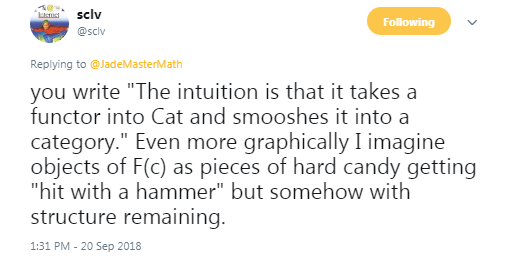Let's Grothendieck Everything In Sight (Week 2)
by Jade Master
Today's post will be topological and maybe not something you've seen before. Before starting I'd like to share an intuition for the Grothendieck construction that was shared with me by twitter user sclv. I think this analogy is better than "smooshing".
 Let's get to it.
Let's get to it.
The n-th singular homology of a topological space gives a functor
$ H_n : \mathsf{Top} \to \mathsf{Ab}$
Where $ \mathsf{Top}$ is the category of topological spaces and continuous functions and $ \mathsf{Ab}$ is the category of abelian groups and group homomorphisms.
You can also take the homology of pairs of spaces which are contained in each other. I won't go through the definition here but for a spaces $ A \subseteq B$, the relative homology $ H_n(A,B)$ intuitively takes the homology of $ A$ if you were to identify all of the elements of $ B$ to a point. This intuition can be made precise through the notion of "good pairs of spaces" (this pdf has a nice definition but it can also be found in Hatcher). Hatcher's Algebraic topology mentions that relative homology is also a functor into $ \mathsf{Ab}$. However, as far as I can tell, neither Hatcher or wikipedia mention what the domain of this functor is.
The Grothendieck construction can help! At first glance it's tempting to guess that the target category is the cartesian product of categories $ \mathsf{Top} \times \mathsf{Top}$. However, this isn't quite true. The most obvious difference is that the second space has to be a subspace of the first but the differences run deeper when you think about morphisms.
A morphism in this category isn't just a pair of continuous maps between the two spaces. Instead, a morphism $ f: (A,B) \to (A',B')$ is a continuous function $ f: A \to B$ which restricts to a continuous map $ f|_{B} : B \to B'$. This is justified by noting that arbitrary pairs of homotopy equivalences don't induce isomorphisms in relative homology. Indeed, take the pairs $ (D^2,S^1)$ and $ (D^2, D^2\backslash \{0\} )$ then $ D^2 \simeq D^2$ and $ S^1 \simeq D^2 \backslash \{0\}$ but the relative homologies are not isomorphic.
Let,
$ F : \mathsf{Top} \to \mathsf{Cat}$ be the functor which sends a topological space $ X$ to the category $ F(X)$ where
- the objects are given by subspaces $ A, A' \subseteq X$ of $ X$ and,
- the morphisms are inclusions $ i : A \to A'$ regarded as continuous functions.
For a continuous function $ f: X \to Y$ we get a functor $ F(f): F(X) \to F(Y)$ which sends a subspace $ A \subseteq X$ to the the subspace $ f(A) \subseteq Y$ and an inclusion $ i: A \to A'$ to the inclusion $ f(A) \to f(A')$.
I think you might be able to guess what we're gonna do next. I'll rewrite the definition here so you don't have to look back.
Let $ F : C \to \mathsf{Cat}$ be a functor. Then the category $ \int F$ is a category where
- objects are pairs $ (c, x)$ where $ c$ is an object of $ C$ and $ x$ is an object of $ F(c)$ and,
- a morphism from $ (c,x)$ to $ (d,y)$ is a pair $ (f, g)$ where $ f : c \to d$ is a morphism in $ C$ and $ g : F(f)(x) \to y$ is a morphism in $ F(d)$.
- For a morphism $ (f,g) : (c,x) \to (d,y)$ and a morphism $ (h,k) : (d,y) \to (e,z)$ their composite is given by $ (h \circ f, k \circ F(h) (g) )$. In words, you map the morphism $ g$ into the category $ F(e)$ and compose it with $ k$ there.
$ \int F$ is a category where,
- objects are pairs $ (A,B)$ where $ A$ is topological space and $ B$ is a subspace and,
- morphisms are pairs $ (f, i) : (A,B) \to (A',B')$ where $ f: A \to B$ is a continuous function and $ i: f(B) \to B'$ is an inclusion. This inclusion makes sure that the continuous function $ f$ restricts to a continuous function from $ B$ to $ B'$.
So now we have a new way of understanding the category in the source of the relative homology functor.
I don't feel like posting the answer to the puzzles in the previous post right now but feel free to talk to me about them. Here's something new to think about
Puzzle: Use the Grothendieck construction to extend the definition of "homotopy equivalence between two spaces" to "homotopy equivalence between two pairs of spaces".
tags: